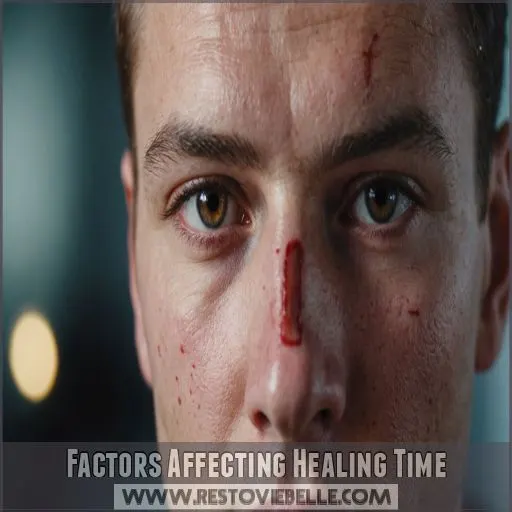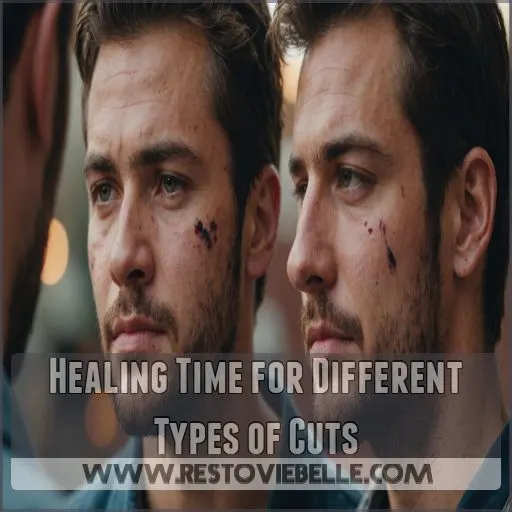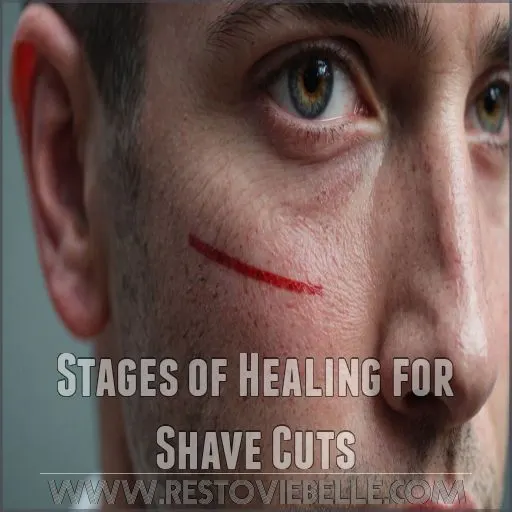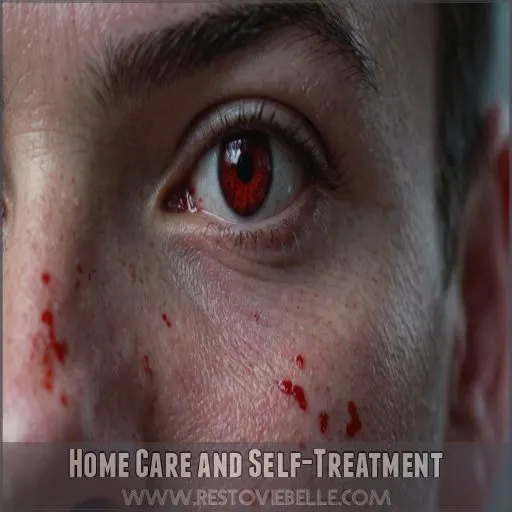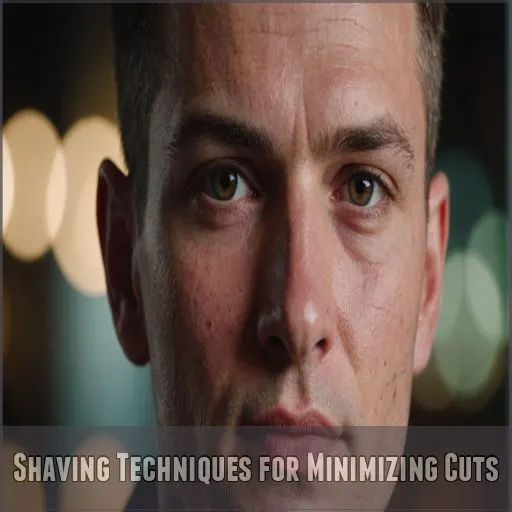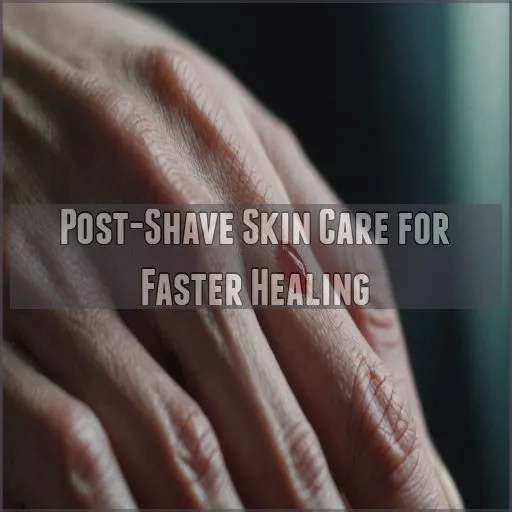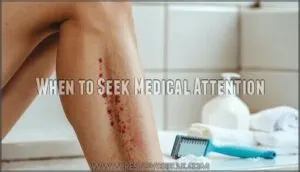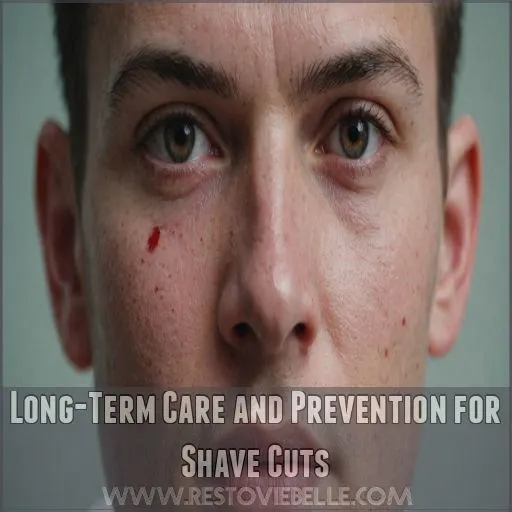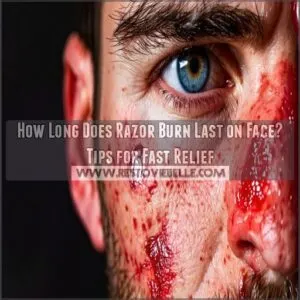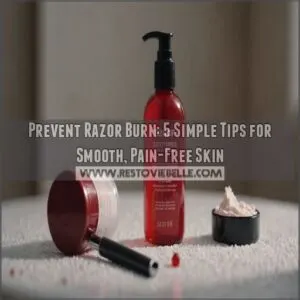This site is supported by our readers. We may earn a commission, at no cost to you, if you purchase through links.
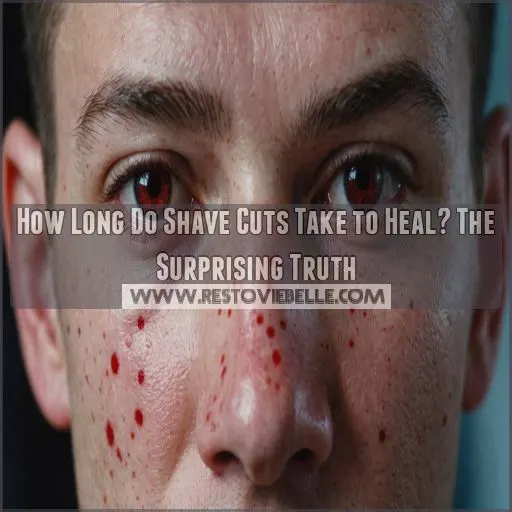
Most minor nicks and cuts will mend in 5-10 days, but deeper razor slices may take 1-3 weeks.
The key is keeping the area clean, moisturized, and protected from infection.
Apply some antiseptic, use a styptic pencil to stop the bleeding, and let that little cut heal up nice and fast.
Just be patient and let nature do its thing – before you know it, your skin will be as good as new. Now, let’s explore some more tips to get those shave cuts healed up in a jiffy!
Table Of Contents
- Key Takeaways
- Factors Affecting Healing Time
- Healing Time for Different Types of Cuts
- Stages of Healing for Shave Cuts
- Effective Remedies for Faster Healing
- Home Care and Self-Treatment
- Common Complications and Prevention
- Shaving Techniques for Minimizing Cuts
- Post-Shave Skin Care for Faster Healing
- When to Seek Medical Attention
- Long-Term Care and Prevention for Shave Cuts
- Frequently Asked Questions (FAQs)
- How long does a shave take to heal?
- How long does it take to heal from rotator cuff surgery?
- How long does a deep razor cut take to heal?
- How long does it take for a cut to heal?
- How long does it take a shave to stop bleeding?
- How long does it take for a skin graft to heal?
- How long do shaving cuts take to heal?
- How to make razor cut heal faster?
- How do you fix a shaving cut fast?
- How long does shaved skin take to heal?
- Can Aloe vera help shave cuts heal?
- How does stress affect shave cut recovery?
- Is it normal for shave cuts to itch?
- Are antiseptic creams necessary for shave cuts?
- Can improper blade hygiene prolong healing?
- Conclusion
Key Takeaways
- Healing shave cuts is quicker if you keep them clean and moisturized. Minor cuts usually disappear in a few days, while deeper ones might stick around for a week or more. Patience and a bit of TLC go a long way.
- The secret sauce for faster healing is antiseptics and a good moisturizer. Use a styptic pencil to stop the bleeding and keep an eye out for any signs of infection—like redness or swelling.
- Cringing at the thought of nicks? Mastering your shave technique plays a huge role. Glide that razor with the grain, and don’t forget to exfoliate—the fewer cuts, the merrier.
- Got a particularly pesky cut? Let it heal at its own pace. Keep it protected and resist the urge to pick at it. Think of scars as your skin’s battle stories; respect their healing time.
Factors Affecting Healing Time
Healing time for shave cuts varies and depends on several factors.
Like how deep the cut is or where it’s located on your body.
Your personal health, hygiene habits, and how well you treat the cut also play a big role.
So don’t slack on that aftershave care!
Depth of the Cut
When shaving, nicks and cuts can vary like life’s little surprises.
Depth plays a big part in healing time; even tiny cuts can take a few days, while deeper gashes need weeks.
Keeping them clean reduces infection risk.
So, channel your inner samurai and handle the blade with care—you’ve got this!
Location of the Cut
The cut’s location plays a sneaky role in how fast it heals.
A shave nick on your face, head, or neck might heal quicker due to better blood flow compared to your legs or arms.
Just remember: head high, stay vigilant, and embrace the healing power of humor (and a good moisturizer).
Happy shaving, minus the razor cuts!
Personal Health and Hygiene
Got a nick while shaving? Don’t sweat it; personal health and hygiene can speed up healing.
Maintain a solid skincare routine, and mind these habits:
- Keep your shaving tools clean to avoid infections.
- Practice good hygiene habits, like washing the area gently.
- Follow grooming tips for post-shave care.
Remember, a little self-care can work wonders for those pesky shaving cuts!
Effectiveness of Treatment
Imagine you’re healing from a shaving cut; it’s a bit like gardening. Your wound’s recovery depends on how well you "water" it—keeping it clean, moist, and protected can boost healing time.
Check this table:
| Treatment | Effectiveness | Time to Heal |
|---|---|---|
| Antiseptic | High | 3-5 days |
| Cold Compress | Moderate | 4-6 days |
| Scab Forming | Low | 5-7 days |
Healing Time for Different Types of Cuts
Ever wonder how long it takes for those pesky shave cuts to heal?
From minor nicks that vanish in days to deeper razor wounds needing more care, let’s unravel this surprising process with a sprinkle of humor and practical advice.
Minor Cuts and Nicks
Minor shaving nicks are a common annoyance.
The good news is they usually heal up in 5-10 minutes with a little TLC.
Just hold a warm, damp cloth on the cut, apply some witch hazel toner, and seal it with a dab of lip balm – easy peasy.
Deep Razor Cuts
When a razor cut’s deeper, it’s no joking matter.
These cuts typically take longer to heal—about one to three weeks—depending on factors like depth and your body’s knack for healing .
To keep infection at bay, clean the wound thoroughly, apply a sterile dressing, and keep it moist with ointment .
Use your best shaving safety practices to avoid future gnarly nicks!
Cuts Requiring Stitches
Got a cut deep enough to call in stitches? You’re not alone, and it’s really important to get it right for a swift recovery.
Proper wound care, like using a styptic stick or a safety razor, helps prevent infection—a real party crasher!
Healing time varies, but stitches often speed things up. Don’t ignore medical attention; it can boost healing and minimize scars .
Stages of Healing for Shave Cuts
Ever wonder why shave cuts start red and end up disappearing like a magic trick?
The healing process is a fascinating journey your skin takes, from inflammation and bleeding to collagen production, tissue repair, and finally, smooth regeneration.
Inflammation and Bleeding
Stepping into a shave mishap? First, tackle the bleeding control like a pro by applying pressure.
Shaving mistakes often invite skin irritation, but don’t stress—witch hazel, alum blocks, or even eye drops can soothe.
Be cautious around sensitive areas like the pubic area to avoid infection risk. Master wound care, and you’ll be back on track in no time.
Collagen Production and Tissue Repair
Next up, collagen production—the unsung hero of healing.
Picture tiny builders weaving a collagen network that restores skin elasticity and strength.
A dose of vitamin C boosts this repair crew, speeding up the process and even preventing scars.
Consider collagen supplements if you’re keen on precision engineering your skin’s recovery.
Keep it up, you’re in control!
Wound Closure and Scab Formation
Ah, the scab formation process during wound healing stages: a nature’s band-aid!
After bleeding stops, your body kicks into gear, forming a protective scab.
It looks unattractive, but resist the urge to pick it. Think of it as your skin’s personal security system against infection.
Let nature work its magic, ensuring scar prevention and embracing natural healing methods.
Scab Removal and Skin Regeneration
Once the scab forms, you’ll want to let it naturally fall off on its own.
Resist the urge to pick at it, as this can disrupt the skin’s regeneration process and increase scarring risk.
Instead, gently cleanse the area and apply a thin layer of petroleum jelly to keep it moisturized (Source).
With patience, the skin will heal beautifully.
Effective Remedies for Faster Healing
Want your shave cuts to heal faster than your morning routine?
Try a mix of soothing tricks like using cold compresses, keeping the wound moist, and applying astringents.
You’ll be ready to show off that baby-smooth face in no time, and be back to your morning routine.
Applying Pressure and Antiseptics
Stopping a shave cut’s bleeding swiftly requires quick action and a touch of care.
Here’s your checklist for recovery:
- Apply Pressure: Firmly press a clean cloth on the cut to stem bleeding.
- Use Antiseptic: Clean the area with a non-alcoholic antiseptic.
- Consider Lip Balm: Seal the cut with balm to block germs.
- Monitor Healing: Watch for redness or infection.
With a little TLC, you’ll be back in the game!
Using Astringents and Styptic Pencils
You’ve applied pressure and antiseptics, but those pesky shaving nicks won’t just vanish.
Astringents tighten skin
Styptic pencils work wonders on tiny shave cuts, stopping bleeding with a sting you’ll feel!
Prefer DIY? Try witch hazel as an alternative.
Choosing between aftershave and a pencil is your next decision!
Applying Ice and Cold Compresses
Ice can be your secret weapon against pesky shave cuts.
Hold an ice cube or cold compress on the cut for 15-30 seconds.
This quick trick helps constrict blood vessels, reducing inflammation and managing swelling, making those nicks feel like they’re disappearing faster than socks in a dryer.
Plus, it offers immediate pain relief and soothing benefits.
Keeping the Wound Moist
Ever tried to heal a shave cut faster by keeping it moist? It’s surprisingly effective!
- Moisturize: Apply petroleum jelly for moist wound healing that speeds recovery.
- Cover: Use a bandage to maintain moisture and protect from dirt.
- Switch Bandages: Change daily or if dirty, to sustain wound moisture balance.
- Avoid Peroxide: Stick to gentle cleansers.
Home Care and Self-Treatment
When you nick yourself shaving, it’s all about tackling the tiny wound with care to speed up healing.
Keep it clean and avoid rubbing it with grandma’s legendary stinging lotions—you don’t need to turn a shaving mishap into a science experiment!
Cleaning and Drying the Wound
First, gently rinse the cut with cool water to cleanse it and reduce the risk of infection .
Then, use a clean cloth or tissue to apply gentle pressure, which helps stop the bleeding and kickstart the natural clotting process.
This simple yet effective approach sets the stage for faster healing.
Applying Topical Creams and Ointments
After you’ve cleaned and dried the wound, consider using topical creams or ointments to speed the healing process.
Think of these products as tiny medics in a tube.
Popular options contain ingredients like aloe vera or hydrocortisone for soothing benefits.
Remember, applying these creams can reduce irritation and keep your skin happy while it gets back to normal.
Avoiding Irritants and Allergens
Why flirt with skin irritation when you can dodge it?
Opt for fragrance-free shaving products and don’t skimp on post-shave care by hydrating your skin with emollient moisturizers to avoid common irritants.
If you’re having a bad skin day, maybe do an allergy test to uncover hidden sensitivities . After all, happy skin equals a happy you!
Monitoring for Infection
Keep an eye out for signs of infection like redness, swelling, or pus. It’s not rocket science!
Follow these key tips:
- Clean the cut with gentle cleansers.
- Slap on an antibiotic ointment.
- Cover with fresh bandages—no fashion statements here!
- If symptoms worsen, high-tail it to a doctor for antibiotics. Better safe than sorry!
Common Complications and Prevention
You’ve probably had that annoying sting after a shaving cut, but did you know ignoring it could lead to complications?
From infections to pesky scars, you need to take proper care
and master your shaving technique to keep those issues at bay.
Infection and Sepsis
Taking an infected cut lightly is like ignoring a dripping faucet—it could lead to sepsis! Recognize signs such as fever, redness, or pus. Proper wound care is vital. Swift action with antiseptics, and, if needed, antibiotics, will keep you in tip-top shape.
The table below outlines key points:
| Symptom | Action | Prevention |
|---|---|---|
| Redness | Clean wound | Keep dry |
| Swelling | Apply antiseptic | Avoid touching |
| Pus | See doctor | Use bandages |
| Fever | Take antibiotics | Monitor closely |
| Pain | Rest area | Good hygiene |
Stay smart and stay safe!
Scarring and Keloid Formation
While it’s comforting to know most shave cuts heal smoothly, occasionally they invite unwanted guests like thick, raised scars called keloids.
Preventing them is all about good care—keep wounds clean and moist, and consider pressure pads or silicone gel for keloid prevention .
If genetics play a role, explore scar treatments, laser removal, or even natural remedies.
Allergic Reactions and Hypersensitivity
Avoiding scars is one thing, but skin sensitivities can add another layer of complication.
If shaving products spark off allergic reactions, watch out for rash symptoms like redness and itching. Common allergens in these products could be the culprits.
Don’t panic, though! Treatment options like soothing creams and avoiding irritants can help you reclaim that silky smooth skin.
Prevention Through Proper Shaving Technique
To keep shave cuts at bay, make sure your razor’s as sharp as your wit.
Pay attention to shaving direction—always with the grain. Skin prep is like stretching before a run, use this time to exfoliate for smooth sailing.
And remember, post-shave care is the cherry on top, soothing skin to prevent pesky razor burn bumps, which is crucial for smooth sailing
.
Shaving Techniques for Minimizing Cuts
Mastering the art of shaving without cuts is like a quest for the perfect cup of coffee—patience and the right ingredients make all the difference.
Use a sharp razor, shave with the grain, and remember that your skin appreciates a gentle touch, not a wrestling match, with a gentle touch.
Using a Sharp Razor and Lubricating the Skin
Imagine stepping into the shave zone armed with a sharp razor and a splash of lubrication.
Regularly replacing your blade makes sure you’re not scraping dull metal across your face—trust me, your skin will thank you!
Whether it’s shaving cream or gel, find what slides smoothly, keeping your skin prepped and pampered, reducing those pesky nicks .
Shaving in the Direction of Hair Growth
Glide your razor smoothly by shaving in the direction of hair growth, sparing your skin from irritation and pesky ingrown hairs. It’s like a mini roadmap to a safer shave!
Try these tips for a happy face:
- Understand Hair Growth Patterns
- Use Shaving Cream Type that Suits You
- Maintain the Razor Blade Angle
- Minimize Skin Irritation
Enjoy a smooth experience!
Exfoliating and Preparing the Skin
Think of exfoliating as your pre-shave ritual for smoother skin.
Different skin types need the right exfoliating tools, like gentle scrubs or loofahs, in your pre-shave routine.
Using these before shaving cream helps remove dead skin, reducing cuts and irritation.
It’s key for sensitive skin folks to avoid harsher options, like those that exacerbate razor burn and ingrown hairs using gentle safety razor blades
! (Source)
Avoiding Aggressive Shaving
Avoiding aggressive shaving is key to preventing nicks and cuts. Ease up on the pressure – let the razor do the work.
Shave in the direction of hair growth to minimize irritation.
Exfoliate regularly to prep your skin, and use a sharp, high-quality razor.
With a gentle touch, you’ll enjoy a smooth, comfortable shave every time.
Post-Shave Skin Care for Faster Healing
Taking care of your skin after shaving can speed up the healing process and keep those pesky shave cuts from sticking around too long.
Keep things smooth by moisturizing.
Skip the harsh stuff, and remember, your face isn’t a pancake—so steer clear of any suns-burnt scenarios.
And most importantly, speed up the healing process.
Applying Moisturizers and Soothing Creams
After perfecting your shaving technique, pamper your skin with moisturizers that soothe and heal.
Opt for creams with gentle ingredients, especially if skin sensitivity’s an issue.
| Moisturizer Types | Cream Ingredients | Healing Benefits |
|---|---|---|
| Cetaphil | Glycerin | Moisturizes deeply |
| CeraVe | Ceramides | Supports skin barrier |
| Vanicream | Fragrance-Free | Reduces irritation . |
Avoiding Harsh Products and Exfoliants
Taking care of your skin after shaving can feel like a dance. Use gentle skincare and dodge harsh exfoliants to keep your skin smooth and soft.
Steer clear of harsh chemicals:
- Opt for natural alternatives like oatmeal-based moisturizers.
- Avoid exfoliation myths—gentler is better after shaving.
- Check product ingredients to prevent irritation for sensitive skin.
Your skin will thank you!
Protecting the Skin From the Sun
Shaving exposes your skin’s vulnerability, making UV protection really important.
Think of sunscreen as your invisible armor against sunburns. Along with broad-spectrum SPF, add a sunhat and sunglasses to your sunny day arsenal. It’s not just about comfort—it’s about safety.
Remember, even overcast days need UV defense.
| Day | Action |
|---|---|
| Sunny | Apply SPF |
| Overcast | Wear hat |
| Cloudy | Don shades |
Maintaining Good Hygiene
Taking care of shave cuts means following a simple routine.
First, keep it clean with gentle washing.
Second, hydrate the area with unscented balm to prevent dryness and itching.
Finally, apply a styptic pencil or antibiotic cream to stay infection-free and speed up healing.
These steps help make sure your post-shave routine keeps you ready for anything.
When to Seek Medical Attention
It’s tempting to shrug off minor shave cuts, but knowing when to get medical help can save you from troublesome infections.
If you’re channeling a horror movie with heavy bleeding or bizarre symptoms like red streaks, it might be wise to swap your razor for a doctor.
Signs of Infection and Sepsis
Uh oh, if you notice red streaks, fever, swelling, pain, or pus around your shave cut, that’s a sign of infection.
You need to see a doctor ASAP. Don’t try to tough it out – an infected cut can lead to serious complications like sepsis if left untreated.
Better safe than sorry!
Severe Bleeding and Trauma
You can keep an eye out for infection, but what about severe bleeding?
If your cut’s acting like a stubborn faucet, it’s time to seek emergency care.
Applying firm pressure with a clean cloth might control some bleeding.
However, if it’s still fountain-like, don’t wait.
It’s essential for your safety to get swift wound management and first aid.
Deep or Large Cuts Requiring Stitches
When facing a deep shave cut, it’s all about knowing when to call in the professionals. If blood’s flowing like a river and won’t stop with pressure, stitches might be your trusty lifeline.
Keep an eagle eye for signs of infection—redness, warmth, or a not-so-chic red streak.
Address these quickly to avoid scarring concerns and help a smooth healing journey .
Long-Term Care and Prevention for Shave Cuts
Taking care of your skin after a shave goes beyond healing nicks and cuts.
It’s about mastering the art of prevention.
With a little attention to detail and some good habits, you can keep your skin smooth and irritation-free, leaving you less likely to resemble a human pincushion.
You can achieve this by maintaining good habits and a well-structured skincare routine.
Maintaining Good Skin Hygiene
Taking care of your skin after shaving isn’t just a routine—it’s your skin’s ultimate spa day!
Remember the trifecta:
- Moisturize to keep things smooth.
- Exfoliate gently to say goodbye to dead skin cells.
- Use sunscreen because, like a vampire, your skin deserves safe daylight outings.
Keep your diet healthy and maintain cleanliness to glow like a skin-care guru.
Using Protective Measures and Pre-Shave Preparations
Before you start shaving, using protective measures and proper pre-shave preparations can feel like having a secret weapon against those pesky nicks.
Pre-shave oils soften hair and boost skin comfort, reducing the risk of razor burn.
For sensitive skin, using a shaving brush helps create a rich lather, while electric razors can be gentle allies in your shaving routine.
Regularly Exfoliating and Moisturizing the Skin
A little TLC in your skin care routine, including a regular shaving schedule, goes a long way toward preventing shave cuts shaving frequency tips
.
Exfoliation benefits by removing dead skin and ensuring a clean shave.
Use the right moisturizer for your skin type to lock in moisture:
- Choose hydrating lotions or gels.
- Apply daily for good skin health.
- Use after shaving prep for smooth results.
Stay smooth and nick-free!
Frequently Asked Questions (FAQs)
How long does a shave take to heal?
Curious about shaving cuts? They typically heal in a few days, just like razor burn.
Meanwhile, be kind to your skin—avoid shaving the area and keep it moisturized.
If cuts linger, consider checking with a healthcare provider.
How long does it take to heal from rotator cuff surgery?
You’ll need some patience with rotator cuff surgery recovery, as it generally takes several months.
Expect to experience pain and soreness, with a sling for about four weeks and ongoing rehab for the best healing.
How long does a deep razor cut take to heal?
A deep razor cut typically takes about one to two weeks to heal.
Be sure to keep it clean.
Apply pressure if it bleeds.
Consider medical care if it doesn’t stop bleeding or shows infection signs.
How long does it take for a cut to heal?
Imagine your skin’s like a repair team.
A regular cut typically takes about 1 to 2 weeks to heal as they work their magic, mending the wall.
Keep it clean and covered for best results.
How long does it take a shave to stop bleeding?
A shaving cut usually stops bleeding in 5-10 minutes with simple treatments like applying pressure or using an astringent like witch hazel toner
.
If it lingers, don’t hesitate to seek medical advice.
How long does it take for a skin graft to heal?
Skin grafts typically take 2-3 weeks to fully heal, but the timeline can vary.
Follow your provider’s instructions closely, keep the area protected, and be patient – your skin will bounce back better than ever!
How long do shaving cuts take to heal?
Minor shaving cuts usually heal in a few days to a week, depending on their depth and your body’s natural healing ability .
Keep them clean and apply ointment to speed up the process and prevent infection.
How to make razor cut heal faster?
To heal a razor cut faster, apply a dab of aloe vera or antibiotic ointment to reduce irritation and prevent infection.
Keep the area clean, avoid shaving over it, and let your skin work its magic.
How do you fix a shaving cut fast?
Stop a shaving cut fast by pressing a warm washcloth.
Then apply witch hazel toner to soothe and disinfect.
Hold ice to constrict vessels.
Finish with lip balm or Vaseline to seal the wound.
How long does shaved skin take to heal?
Your skin usually heals from a shaving session within a few days.
Razor burn clears up quickly, often in a day or two.
If cuts occur, keep them clean to aid faster healing.
Can Aloe vera help shave cuts heal?
Think of Aloe vera as nature’s band-aid.
It’s got your back when you nick yourself shaving, thanks to its soothing properties that help reduce irritation and keep infection at bay.
Promoting quicker healing.
How does stress affect shave cut recovery?
Stress might throw a wrench in your shave cut’s recovery by slowing down the healing process.
It boosts inflammation and hinders the body’s ability to repair, making those nicks linger longer than you’d prefer.
Is it normal for shave cuts to itch?
It’s totally normal for shave cuts to itch – that’s just your skin’s way of telling you it’s healing.
Just resist the urge to scratch, and you’ll be back to smooth sailing in no time.
Are antiseptic creams necessary for shave cuts?
Over 57% of minor cuts heal fine without antiseptic creams.
For shave cuts, just clean with water, pat dry, and add a bandage if needed.
Save the cream for cuts that seem infection-prone.
Can improper blade hygiene prolong healing?
Dirty razor blades can indeed put a dent in your healing journey by introducing bacteria to shave cuts.
Keep those blades squeaky clean to avoid infections and enjoy smoother, quicker healing.
It’s really worth the effort, especially to avoid negatively impacting your healing journey. (Source).
Conclusion
Surprisingly, about 70% of shave cuts heal within a week if you follow proper care.
By keeping the area clean and moisturized, you’ll help those annoying nicks disappear faster.
Remember, how long it takes for shave cuts to heal depends on the cut’s depth and your care routine.
So, treat your skin gently, use the right shaving techniques, and keep infections at bay.
With patience and a little TLC, your skin will soon be back to its best.

